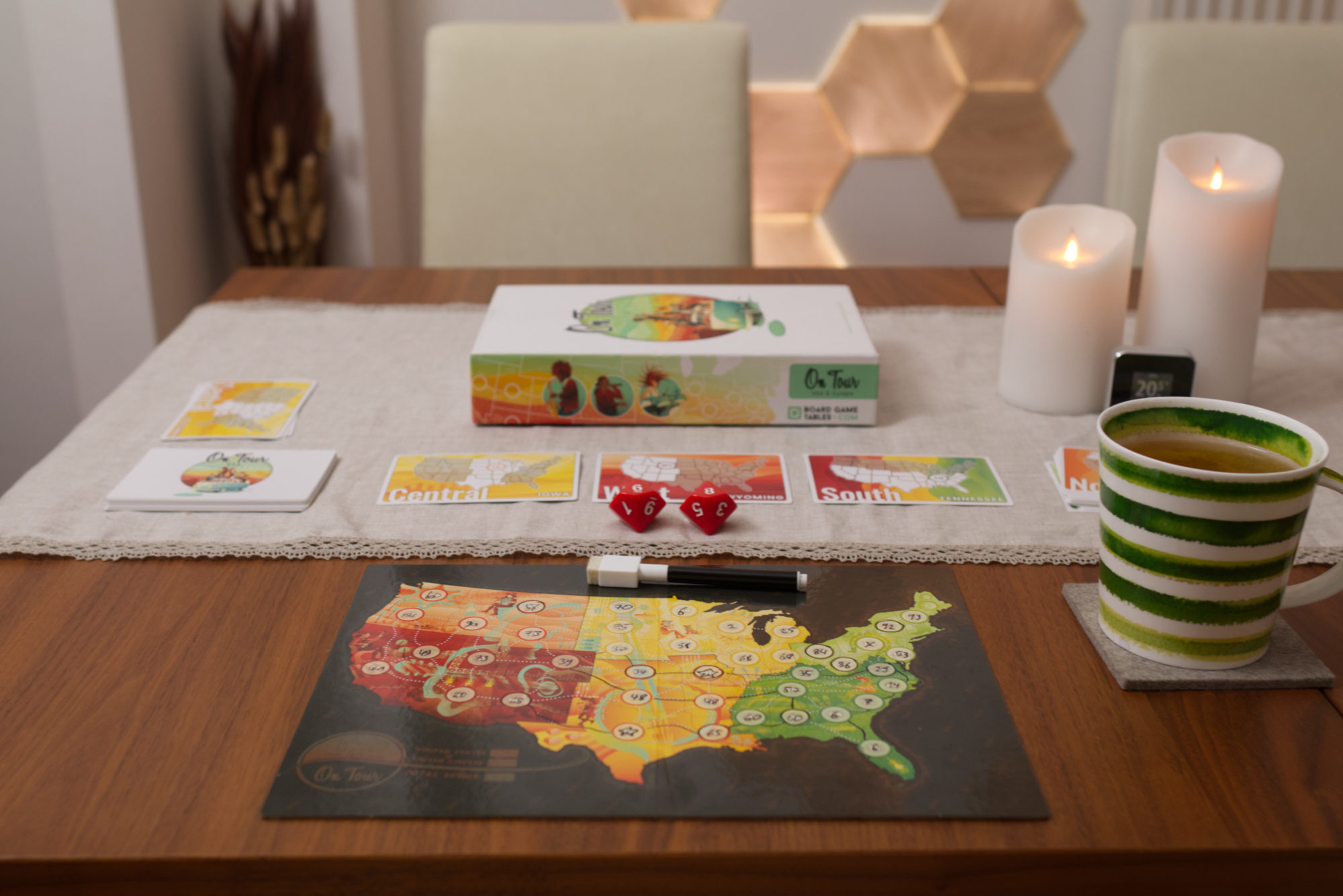I’m not the biggest fan of roll-and-writes, but I’ve played my fair share of them. From simple ones like Railroad Inc or Saint Malo over combotastic ones like Ganz Schön Clever to more complex ones like Troyes Dice, Welcome to the Moon or Hadrian’s Wall. At some point, I got rid of all of them. While there is something fascinating about the concept and its highly variable player count (thanks multiplayer-solitaire!), most roll-and-writes I’ve played felt trivial after a couple of plays. The same was true for me when it came to On Tour. I tested it once in a board game café and promptly checked it off my list. Nothing special here, next.
By chance, I recently found a used copy for a good price and thought I give it another shot. As a musician myself, I liked the theme and the designer in me liked the clean but colourful art style. And what can I say: this little game has really grown on me. But the simplicity of its rules puts me as a writer in a somewhat awkward place. What’s there to tell? The whole game can be explained in less than a minute.
So instead of the normal formula, let’s instead go through the various emotional stages of playing a roll-and-write and why this it the one that works for me.
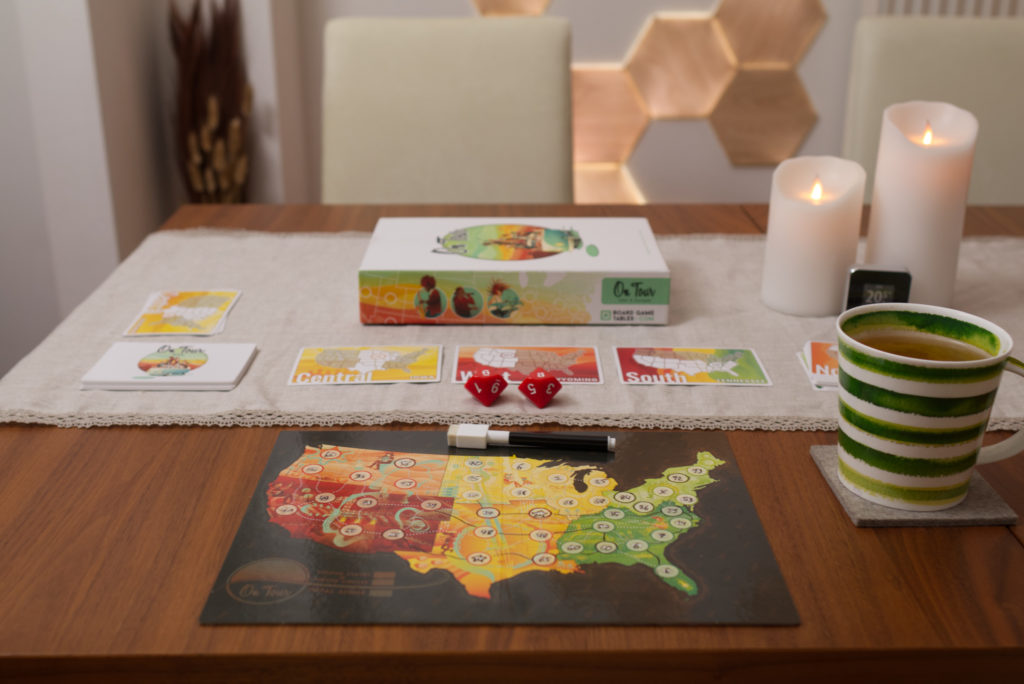
Initial Curiosity
Let’s be honest. A big part of choosing which game to play is the promise that its box and components make. Presentation-wise, On tour does a lot right. The box is larger than most roll-and-writes but still compact enough that one can easily fit it in a rucksack. Its clean white background works perfectly as contrast to the bright coloured artwork in the center of the cover. Unfortunately, mine slid off a pile of games during transport and hit the pavement hard, so it’s not as pristine as one might hope. Still, looks inviting and the concept of a band on tour is something most people can relate to.
Inside the box are 8 coated, double-sided map boards and dry-erase markers, two decks of oversized cards, and two satisfyingly large, chunky dice. At least that’s the edition I got. In its original Kickstarter run, the boards only showed the USA map and the number of boards ranged between 4 and 12 depending on pledge level. More recent editions also contain the Europe map on the backside of the USA map. So if you plan to buy this game, be careful what edition and how many boards you get!
Anticipation of the Challenge Ahead
The rules of On Tour are quite simple: the map (I’ll be sticking with the USA side for now) shows all the continental states of the US minus Alaska and for each one, a single matching card exists. The map is split into 6 areas: Northwest, North-Central, Northeast, Southwest, South-Central, Southeast. Besides the state, each card also shows one of five regions (North, South, West, Central, East). During setup, the dice are rolled and a card is drawn. The smaller combination (e.g. 5 and 2 combine to 25 and 52) is written into that state with a circle around it. Draw a new card for the higher combination, then roll again and proceed as with the first die roll. As a result, all players start with the same four numbers in the same four states.
Your task is to create a connected route of increasing values, the longer, the better and circled states count double. Each round three cards are drawn, the dice are rolled, and each player needs to use two of the cards to put down both combinations of the dice. The value can be written into any state that lies within the region show on the card, so for example anywhere in the West. If the player choses to put it into the exact state shown on the card, they are allowed to put a circle around the number. Obviously, the more the game progresses, the less choices there are.
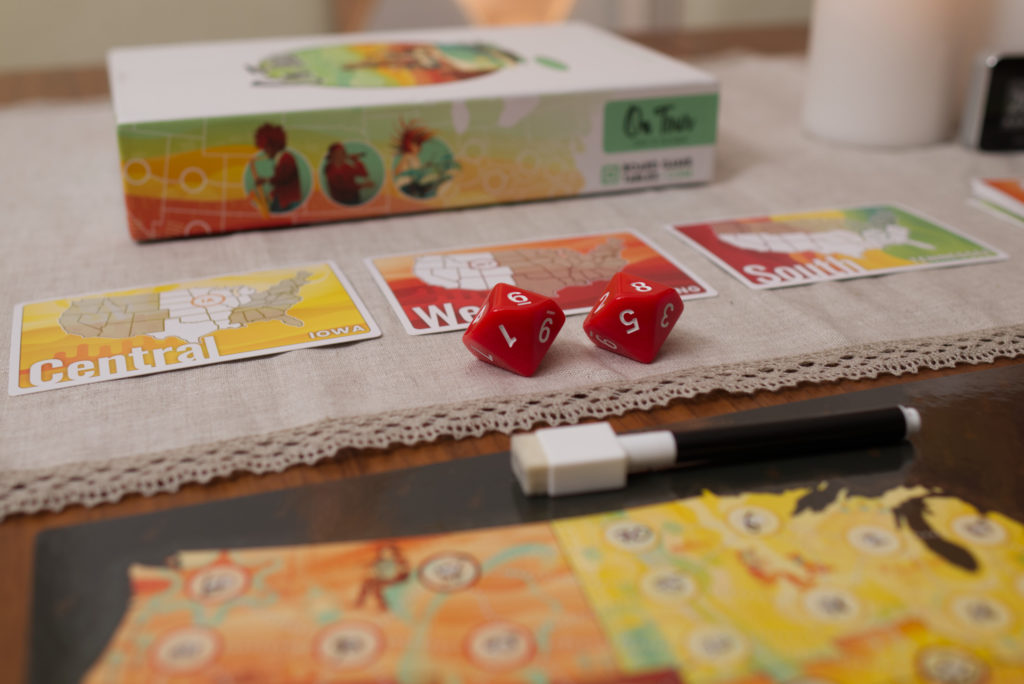
Over-Confidence Leading to Problems
The general challenge is easy to grasp and but since the board is still empty, new players quickly have lofty aspirations of connecting the whole nation. Fill in the numbers, plan a good route, seems easy, right? What puts additional spice into the sauce is the constant lure of wanting to use the exact state printed on a card to put that precious circle around it. Double points for a city is nothing to laugh about, tempting players to put numbers in less than optimal positions. How hard can it be to get 2 more numbers between 72 and 76, right?
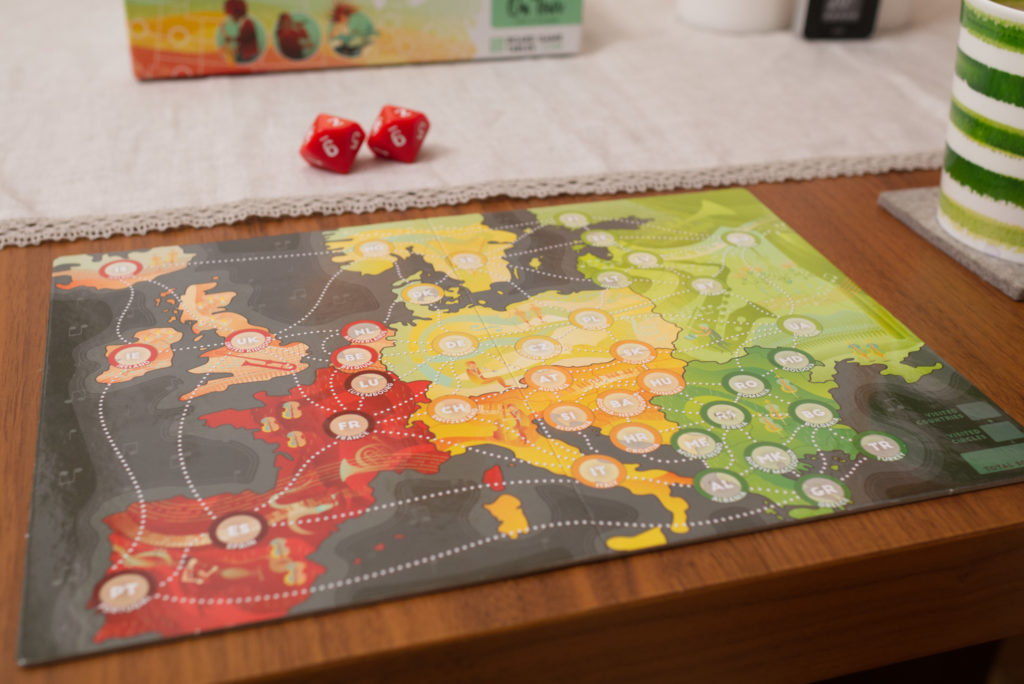
The Dread of Realisation
As the game progresses, a feeling of dread mixes in as players realise how limiting the three cards truly are. If a player for example has already filled in all cities in the west, they no longer can use any of those cards. That may force them to place the perfect number they needed in the worst region possible. It is even more heartbreaking when there is still that one crucial state open that you need to connect both ends of your carefully crafted route. In your mind, you might feel safe because you still have lots of states that you don’t care for and plan to put rubbish in anyway… when suddenly all cards show regions that force you to put that rubbish into the very regions you don’t want to. In the session below, I had this beautiful route all crafted out, and then the game forced me to put a 20 into Arizona, cutting my imaginary route in half! From the 84 and through the east, I had build a nice second stretch of my tour that I no longer would be able to reach. Well, at least after that having to put the 58 in Iowa and two 68s into Illinois and Indiana didn’t matter that much anymore.
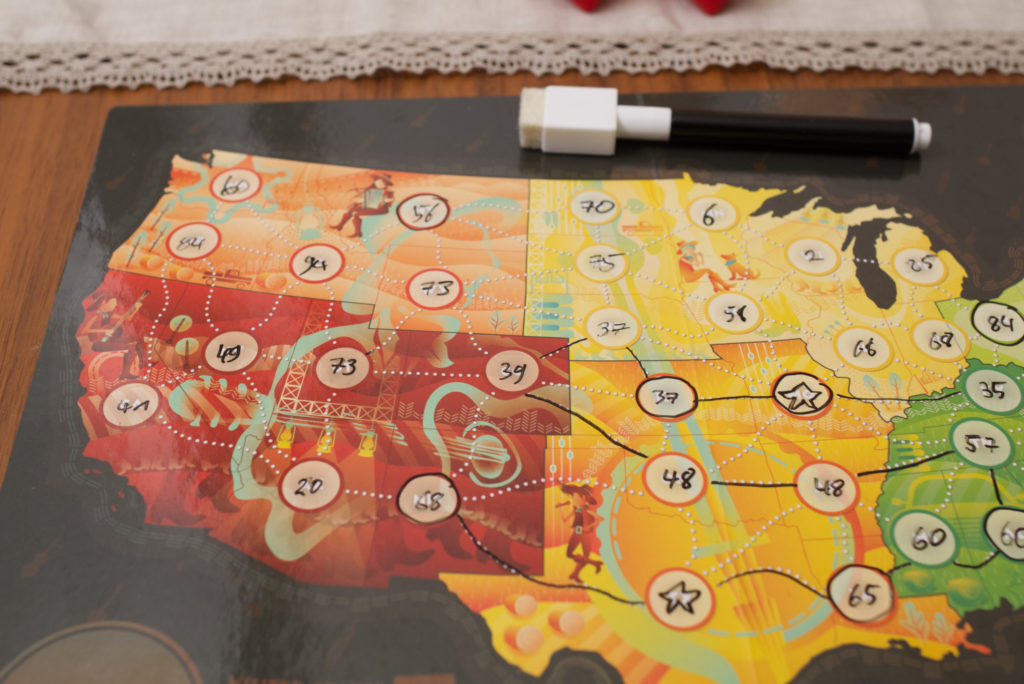
While the cards are bad, the dice are even worse: It can very well happen that player’s won’t see any numbers between 40 and 60 for the complete second half of the game! Or the perfect number comes at the wrong time.
Hope Prevails
Still, there is always hope. If all three cards show the same region, a star is put down which acts as any number at the end of the game. Same if a double is rolled. In addition, routes don’t have to be strictly increasing but can go through multiple states with the same value (e.g. …-27-32-32-star-32-37-…). This produces a surprisingly large number of cases where players can re-route their tour and at least create a somewhat competitive result.
Anxiousness of Things to Come
The game ends when all states have a number filled in. When there are only 2 or less states still open, no cards are drawn and the rolled combinations have to be put into those states. What’s interesting is that players don’t actually draw their route during the game but only at the end of it. So while they might have planned to go a certain way, the stars and some unplanned placements of numbers might give them an alternate way of making at least some points.
Tallying up the final score is easily done and usually followed by that anxious look, up from the board and into the eyes of the other players, asking how many points they have earned, hoping against all odds that disaster might have struck them just a little bit more than yourself. Winning scores in my games usually ranged between mid-twenties to low-thirties.
Relief in Shared Misery
In the end, nobody ever manages to fulfil that perfect initial plan. On Tour is all about stretching while not overstretching, keeping options open, and sharing the delight that misery likes company. During play, one often hears “oh not, not the North” or “why, oh why is there NOTHING in the seventies?”. But since a single game is over rather quickly (20-30min), it produces a “let’s try that again” vibe. Still, it is substantial enough that wrong moves feel like they have consequences.
Conclusion
So why does On Tour work for me where other roll-and-writes don’t? It’s that pure emotional rollercoaster. The artwork is inviting, the rules super easy to get, I don’t have to explain a lot of iconography, turns are quick as there is hardly any room for AP. It has that “anyone can do that” vibe. Most of all, the challenge is relatable. What I mean is that a lot of roll-and-writes are far in multiplayer-solitaire territory. At the end of the game, it’s difficult to figure out where one player has taken a wrong turn and someone else did a clever zig where others zagged. Take for example Railroad Inc, which I put among the better roll-and-writes. At the end I usually don’t even bother to see what other players have done on their map.
In On Tour, the solution space is limited enough that anyone can quickly understand where others have plotted their routes, had choke points, and may have used the same numbers in a slightly better way. Often one player will give tips to another on how to draw their route in a more optimal way. It would be an exaggeration, but in some part it feels like On Tour is two games in one: first find the best place to put down numbers, then find the best route through the hot mess that you produced.
Being able to fit 8 boards into the box is also something I appreciate. This makes it both a nice relaxing solo I can break out after a stressful day as well as a great filler when my group is larger than expected. The two maps feel similar, but I prefer the Europe map as it has only 9 states in the West, compared to the 12 in Central and 16 in East. This produces a cool imbalance and often leads to juicy problems mid game.
The biggest downside for most roll-and-write fans will be that there is no combing at all. This is definitely no Hadrian’s Wall, not even a Troyes Dice. Personally, I found that as soon as a roll-and-write tries to increase its complexity to or beyond a Welcome to the Moon level, the juice is not worth the squeeze. If I have to read pages of rules and learn whole set of iconography, I rather break out a bigger board game. On Tour stays in that approachable, low-complexity segment that makes it a perfect fit if you’re looking for a bite-size spatial challenge.
